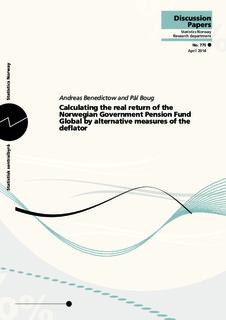Calculating the real return of the Norwegian Government Pension Fund Global by alternative measures of the deflator
Working paper
Published version

View/
Date
2014-04Metadata
Show full item recordCollections
- Discussion Papers [1002]
Abstract
According to the present guidelines for fiscal policy, the use of oil revenues in the Norwegian economy should over time equal the expected real return on the Government Pension Fund Global (GPFG). An important question is therefore how to measure the real return, taking into account that the aim of the investment strategy of the GPFG is to maximise the purchasing power with respect to future Norwegian imports. In this paper, we present estimates of average annual real return of the GPFG over the sample period running from 1998 to 2012 based on alternative measures of the deflator. We find that the choices of international price measure, weighting scheme and method of aggregation generally are of major importance for the measure of the deflator, and thereby for the estimate of the real return. Two major factors providing low estimates of inflation and, thus, high real return, are GPFG weights dominated by western, low inflation countries, and export prices growing relatively slow, possibly due to strong international competition. Applying a method of aggregation tailored to also capture the deflationary effects of Norwegian imports increasingly originating from low cost countries (known as the China effect), reduces the estimate of inflation by close to one percentage point. We present estimates of average annual real return of the GPFG ranging from 2.3 to 3.3 per cent, and up to 4.5 per cent including the China effect. The present practice of calculating the deflator, based on CPI inflation in the countries the GPFG invests in, delivers an estimate of average annual real return of 3.1 per cent, which is close to the middle of this range.